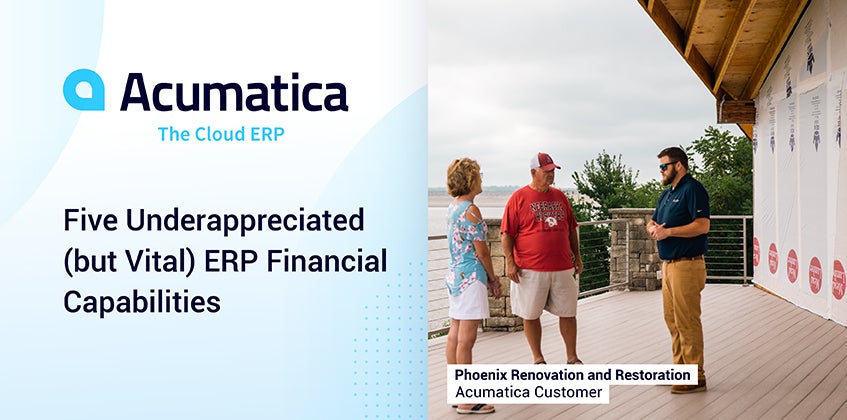
Every small to mid-sized business (SMB) is unique. Who you are, what you produce and how you sell your goods and services set you apart. However, all businesses share a common challenge: effectively managing accounts receivable (AR: your cash flow and how much money is owed to you) and accounts payable (AP: how much money you’re paying out) processes.
How well—or not so well—you handle your accounting responsibilities could be a make-or-break situation. As Donna Fuscaldo of Business News Daily points out, “Staying on top of your accounts payable and accounts receivable is vital to the health of your business….They help you prevent unexpected expenses that could throw even the best budget off course.”
So, what’s the best way to achieve AP and AR accounting success? Investing in a modern enterprise resource planning (ERP) solution with integrated AP and AR functionality. As I shared in a recent blog, robust ERP financial capabilities provide a number of benefits, including:
- Improved efficiency with ERP-driven automation.
- Complete visibility across all AP and AR workflows.
- Consistent record keeping for audit trails.
- Cloud-based enterprise security.
- Better supplier and vendor relationships.
These five benefits ensure your team members are more accurate—thus reducing data entry errors, rework, and stakeholder dissatisfaction—and increase their productivity, which allows them to spend less time entering documents and more time performing higher value tasks. With all of this in mind, let’s look at five of the most vital but often underappreciated ERP financial capabilities that can make your most challenging accounting and financial management duties a breeze.
5 ERP Financial Capabilities For SMBs
- Seamless Multi-Vendor Payments
As an SMB, you likely contract with multiple vendors, and they—like you—expect timely payment for products and services. But cutting checks, scheduling wire transfers, and providing credit cards to individual vendors takes a lot of time and manpower and is often complicated by avoidable human errors. With ERP accounts payable features, you can easily set up simultaneous payments for multiple vendors, automating the payment process with just a few clicks and creating a seamless experience for everyone. Additionally, you can utilize artificial intelligence (AI) and machine learning (ML) to import vendor bills and to intelligently guide you through the approval process.
- Streamlined Approval Processes and Smart Tracking of Due Dates
A modern ERP solution lifts the burden of tracking payment due dates (yours or your customers) manually or with disconnected, outdated technology. It provides AP and AR aging reports that deliver information about total outstanding balances and past due accounts, helping you make payments on time and take advantage of potential vendor discounts as well as ensuring you’re paid on time and in full.
Approving both AP and AR invoices is a multi-step task. AP involves reconciling vendor bills against purchase orders, sending bills for review and approval, paying the vendors, and reconciling bank transactions. AR involves generating invoices, sending statements, collecting payments, managing delinquencies, and verifying balances.
When handled manually, AP and AR invoicing is a slow, tedious process that requires multiple employees, emails, and spreadsheets—not to mention possibly other paper trails—but, when managed by an ERP system for finance and accounting, it becomes streamlined and efficient. The ERP solution automatically approves payments or follows a pre-determined approval process.
For AP, you can designate specific payment methods, reducing the number of people involved and preventing delays. And for AR, you can stay on top of delinquencies and maximize incoming cash via dunning letters, write-off capabilities, and financial terms.
ERP financial management and accounting capabilities also offer insights you can use to analyze your AP and AR needs, vendor performance, and cash requirements.
- Comprehensive Cash Flow Management
Cash flow is key to covering expenses and growing your business. To effectively manage it, invest in an ERP solution that will help you track all your needs in one, centralized solution with powerful cash management functionalities. You should be able to:
- Utilize near real-time data along with upcoming cash receipts and payments to get a complete picture of your current cash position.
- Automate payments to vendors to optimize cash discounts and your cash balances.
- Gain insights by centralizing reporting and drilling down across departments, companies, and branches.
- Reconcile bank balances with automated bank downloads and transaction matching.
- Improved Tracking and Communication
To be efficient, your AR and AP teams must be able to access accurate data and communicate quickly, which means they don’t have time to export information from one system to another or use spreadsheets that may lead to inaccurate, old data as well as errors and confusion.
AR and AP functionality integrated within an ERP solution provides you and your team members with up-to-date information (e.g., payment (coming or going) status, customer data, and payment disputes) in one, centralized location, empowering active collaboration between team members and making it easier to track payments and manage issues.
- Proactive Monitoring of Rising Costs
An ERP solution with integrated AP and AR capabilities can flag and monitor rising costs, so you can proactively manage your cash flow based on real-time, accurate data. Instead of generating a budget based on hunches, you’ll have accurate forecasts and can reduce risk.
Applying ERP Financial Capabilities in Real Life
So, how can ERP financial capabilities apply to your real-life business? Clive Coffee is a great example.
Clive Coffee is a leader in the luxury home espresso market, selling equipment and accessories—and offering free, expert advice—to avid coffee drinkers. Clive Coffee also designs personalized coffee subscription services and has a Coffee School to help everyday consumers become at-home baristas.
During the pandemic, Clive Coffee closed its physical stores and focused solely on online sales. Says Amanda Datte, Clive Coffee’s CFO, “A lot changed for Clive in 2020. Before, we had a showroom and some in-person sales. But now that everybody is working from home and wanting coffee, we’re now 100 percent online, and our business has really taken off.”
Unfortunately, the Clive Coffee team’s excitement at their booming success was stifled by the inefficiency of their disconnected business management systems, including QuickBooks and other inventory, order, and eCommerce software.
“We were growing so fast, and it never felt like we were caught up. As soon as we finished one month, got all the details aligned, got them into QuickBooks, and got our balance sheet up to date, another month had already gone by. It was just a stressful environment,” Datte says.
To ease the pain of operating with multiple, siloed systems, the team decided to look for a centralized solution. After comparing a number of ERP options, including SAP, Oracle NetSuite, and Acumatica, Clive Coffee determined there was only one that worked.
“We found a perfect size for us in terms of cost and flexibility, which was Acumatica,” Datte says. “As soon as we saw Acumatica demos and heard everything about how versatile it could be, it was hard to keep looking at anything else. We knew Acumatica was a solution that we could grow with. We knew that it wasn’t going to limit us to what we could do. There is a lot of possibility for Clive and how we want to continue to expand.”
Clive Coffee implemented Acumatica in six months, and the team now enjoys instant, accurate, and automated financial reporting and a shorter month-end close cycle. Says Datte, “I can look at any point in time to see, ‘Are we meeting our forecasted projections? And do we have the right infrastructure to continue to stabilize this growth?’”
She adds, “With everything built-in, our invoices now directly populate into our revenue and onto our P&L, and executives can pull information at any point in time. They can see how profitable we are this month. They can see what we’re purchasing. They can have many questions answered at any point in time.”
Learn More About Acumatica’s ERP Financial Capabilities
For more information on how your business, like Clive Coffee, can benefit from Acumatica’s ERP financial capabilities, contact our experts today.
As Datte says, “The world is your oyster in terms of possibilities for efficiency and having seamless operations. We feel like we are prepared by using Acumatica for whatever the market has to offer. It’s going to be a big part of our company now and into the future, and we’re very excited to continue growing that.”
 Canada (English)
Canada (English)
 Columbia
Columbia
 Caribbean and Puerto Rico
Caribbean and Puerto Rico
 Ecuador
Ecuador
 India
India
 Indonesia
Indonesia
 Ireland
Ireland
 Malasya
Malasya
 Mexico
Mexico
 Panama
Panama
 Peru
Peru
 Philippines
Philippines
 Singapore
Singapore
 South Africa
South Africa
 Sri-Lanka
Sri-Lanka
 Thailand
Thailand
 United Kingdom
United Kingdom
 United States
United States






